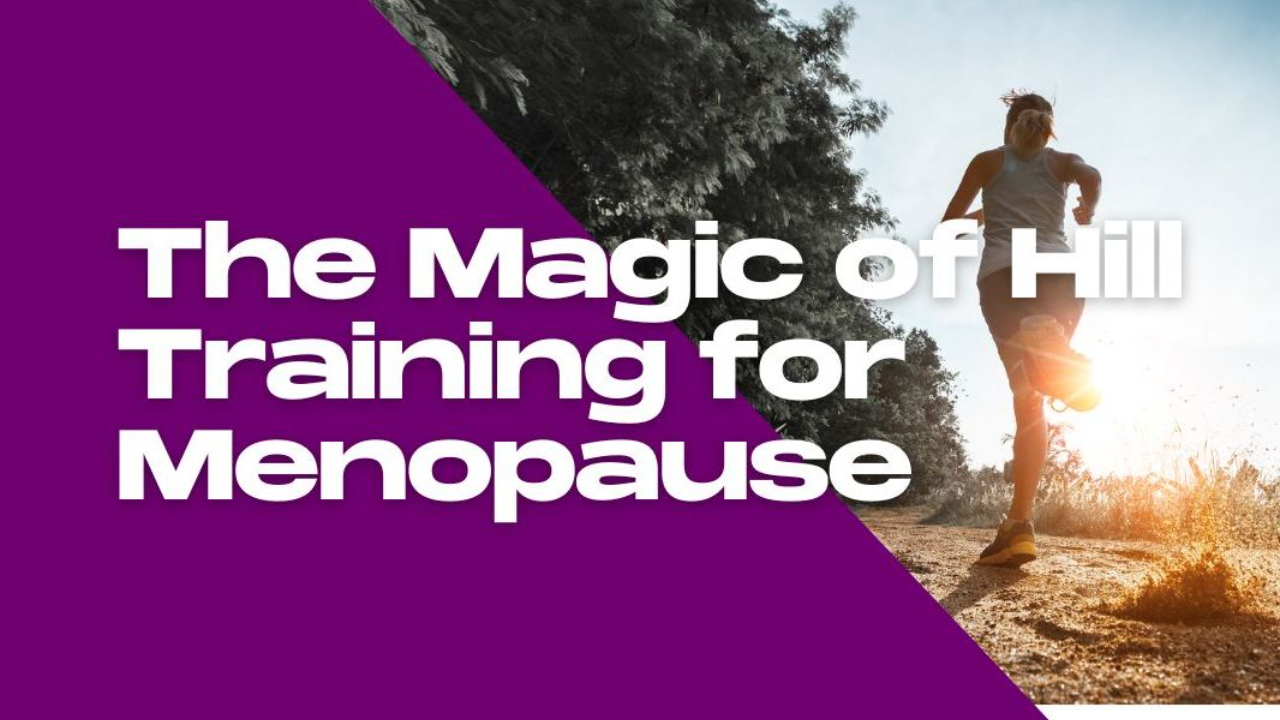
The Magic of Hill Training for Menopause
May 10, 2023Head for the hills for increased strength, endurance, metabolism, mental toughness, and more.
By Selene Yeager
High-intensity intervals—especially those short, sharp, “Whoo! This is hard!” sprint type of intervals—are very good for menopausal metabolic, cardiovascular, and musculoskeletal health.
When it comes to running, some women are reasonably reluctant to do high-intensity interval work because of fear of getting hurt. That’s where hill training comes in. By pushing against the pull of gravity, your effort increases without the increased injury risks that those not accustomed to speedwork can face.
Even seasoned runners often turn to hill work as they get into midlife and menopausal years to get the benefits of the increased training stress without the potential strain, as legendary ultra-runner Magda Boulet explained in episode 12 of Hit Play Not Pause. “I run uphill for 30 seconds 20 times,” says Boulet. “I do a lot of hill repeats that are hard and are not as hard on your body as speedwork on the track, which I still do, but less often.”
Hill work can also help you build strength for longer runs, which is a huge part of my training as I get ready for an upcoming Ironman 70.3 after a 10+ year hiatus from triathlon. As my coach, exercise physiologist, and 19-time Ironman finisher Marni Sumbal explains, “We prescribe hill intervals over the typical speedwork. You will get your heart rate up much quicker uphill versus during speedwork on a flat road. It’s the best way to improve running durability and resiliency while keeping the risk for injury low.”
Note: Hill work can also be helpful for cyclists. While it’s not as jarring on your joints to do sprint work on a bicycle, there are still inherent challenges and risks with going full speed on two wheels (unless you’re on a trainer or stationary bike). Hills are also an easy way to get intensity—and get the benefits of HIIT work—on a bike.
How Hill Training Works
Still not convinced? Here’s a look at how hill training works its menopausal magic.
Boosts Performance!
Uphill efforts send your heart rate into anaerobic territory and boost your cardiovascular fitness. This is true even if you’re already well-trained. A study on middle and long-distance Ethiopian runners showed that a group of club runners doing two sessions of hill work per week for 12 weeks significantly improved their VO2 max, resting heart rate, speed, and endurance over their peers who did not incorporate hill training. Another study on well-trained runners found that six weeks of incorporating hill training significantly improved the runners’ economy (i.e., how much energy they expended running), but also improved their performance in a 5K time trial by 2 percent.
Builds Strength!
When you work uphill, you engage more muscle fibers, not just in your lower body (especially your calves and glutes), but also in your core, which has to work harder to stabilize you on the incline, as well as your upper body as you swing your arms to maintain strong forward momentum. This also translates to more power and speed when you hit the flatter ground.
Improves insulin Sensitivity and Metabolic Health!
Research shows that HIIT significantly improves insulin sensitivity, which can help lower fasting blood sugar levels, and is good for your overall cardiovascular and metabolic health, especially during the menopause transition when blood sugar can be harder to manage. Research on uphill walking found significant improvements in glucose metabolism and blood lipids.
Decreases Belly Fat!
High-intensity efforts like hill training are especially good for reducing total body fat, total abdominal and deep visceral (i.e., the type that is linked to metabolic disease) fat in midlife and menopausal women.
Builds Muscle!
Research shows that sprint training can increase lean muscle mass in menopausal women, and hill training specifically is like a form of resistance training as you recruit all your muscles to fight the pull of gravity.
Mental toughness!
Hills are hard—that’s why we’re here. Incorporating regular hill training into your routine also builds your mental toughness and reserve.
How to Do Hill Work
Ready to head to the hills? Here’s how to get it done. (These can also be done on a treadmill if you prefer indoor training or don’t have a hill available.) Do hill work 1 to 2 times a week.
Warm-up. As with any challenging form of exercise, you want to go into your hill training with a proper warm-up. Power walk into a jog (or do whatever form of exercise you’re doing at a lower intensity) for 10 to 15 minutes to get your heart rate up and your muscles and connective tissues warm and ready to go.
Hit your hill. Look for a moderate to steep incline (making sure it’s not so steep that you can’t maintain good form). Then do a set of hill repeats. If you’re new to hill training, start with just 10 to 20 seconds of a strong uphill effort. If you’ve got some experience, you can start with 20 to 30 seconds. After each uphill push, walk back down the hill, giving yourself one to two minutes to recover before the next effort. Start with 4 to 6 repeats. Work your way up to 6 to 8. As you get stronger you can make the uphill efforts a bit longer, but cap it at 45 to 60 seconds so you can keep the effort strong throughout.
Cool down. After you’re done, jog, or power walk it off to cool down.
Get Feisty 40+ in Your Inbox
We hate SPAM. We will never sell your information, for any reason or send you emails that suck!


